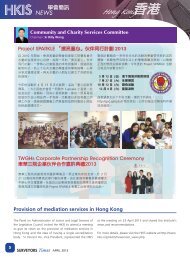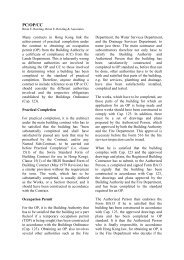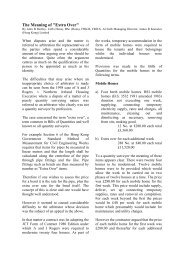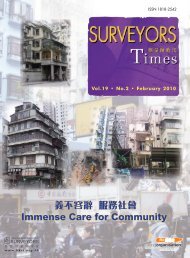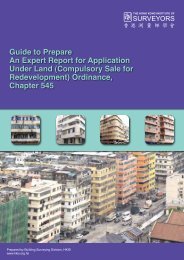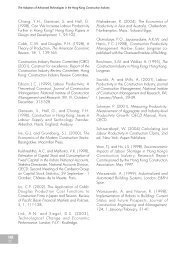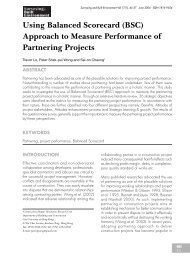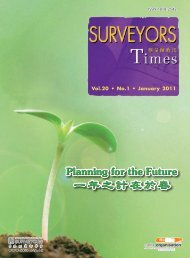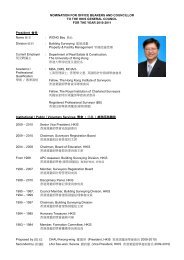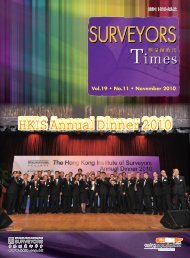Special issue to commemorate the 70th Anniversary of the Battle of ...
Special issue to commemorate the 70th Anniversary of the Battle of ...
Special issue to commemorate the 70th Anniversary of the Battle of ...
Create successful ePaper yourself
Turn your PDF publications into a flip-book with our unique Google optimized e-Paper software.
War and Peace: Economic Rationales for Preserving War Relics<br />
<strong>the</strong> peace model can be preserved by rationalizing<br />
violence, even for conflicting regimes. Again,<br />
rationalizing violence completely would mean that acts<br />
<strong>of</strong> violence fall <strong>to</strong> zero.<br />
There is a different angle <strong>to</strong> addressing <strong>the</strong> peace<br />
model that can serve as a prelude <strong>to</strong> <strong>the</strong> next section in<br />
<strong>the</strong> discussion <strong>of</strong> violence. That is, with <strong>the</strong> exception<br />
<strong>of</strong> small communities where self-enforcing equilibria<br />
are <strong>of</strong> <strong>the</strong> simplest type, most communities do require<br />
specialists <strong>of</strong> violence. 7 Like any pr<strong>of</strong>ession, some<br />
specialists are born <strong>to</strong> be skillful at things <strong>the</strong>y can<br />
do, some need <strong>to</strong> be trained <strong>to</strong> become specialists.<br />
Regardless, <strong>the</strong> existence <strong>of</strong> certain humans in <strong>the</strong><br />
species with ability <strong>to</strong> visit violence on o<strong>the</strong>r humans<br />
can be analyzed not only in terms <strong>of</strong> <strong>the</strong> genes <strong>of</strong> Cain<br />
(according <strong>to</strong> <strong>the</strong> Bible), but as <strong>the</strong> necessary result <strong>of</strong><br />
<strong>the</strong> economists’ notion <strong>of</strong> comparative advantage in<br />
specialization.<br />
WAR: ORGANIZED VIOLENCE<br />
<strong>Special</strong>ization implies that <strong>the</strong> execution <strong>of</strong> violence<br />
can be treated as a pr<strong>of</strong>ession like any o<strong>the</strong>r activity<br />
in a society. Those who do not wish <strong>to</strong> (or do not<br />
have a comparative advantage in) use violence will<br />
want <strong>to</strong> seek protection from those who are able and<br />
willing <strong>to</strong> do so. The gain from trade in <strong>the</strong> forming<br />
<strong>of</strong> this exchange is mutually beneficial; and as such,<br />
sustainable from <strong>the</strong> point <strong>of</strong> view <strong>of</strong> <strong>the</strong> human<br />
species as a whole, as well as possibly for o<strong>the</strong>r specie.<br />
Economists have <strong>of</strong>ten characterized exchanges in<br />
terms <strong>of</strong> <strong>the</strong> demand and supply <strong>of</strong> goods and services<br />
being exchanged. There is no reason why <strong>the</strong> same<br />
analysis cannot be applied for violence as a pr<strong>of</strong>ession.<br />
War can thus be analyzed as a market in <strong>the</strong> demand<br />
and supply <strong>of</strong> violence; or, <strong>the</strong> flip side <strong>of</strong> <strong>the</strong> same<br />
problem, <strong>the</strong> demand and supply <strong>of</strong> protection. 8<br />
Viewing wars as outcomes <strong>of</strong> <strong>the</strong> demand and supply<br />
<strong>of</strong> protection can provide a way <strong>to</strong> view war as<br />
organized violence. A subfield in economics called<br />
industrial organization (IO) emphasizes how firms<br />
and industries are organized. Applying <strong>the</strong> IO concept<br />
<strong>to</strong> <strong>the</strong> market for protection can tell us a lot about<br />
how organized violence can be structured. Basically,<br />
<strong>the</strong> market structure depends on <strong>the</strong> cost structure <strong>of</strong><br />
organizing protection, which has a fixed cost and a<br />
variable cost component. The fixed cost is invariant <strong>to</strong><br />
<strong>the</strong> number <strong>of</strong> people and assets being protected. The<br />
variable cost increases as number <strong>of</strong> people and assets<br />
being protected increase. Military forces, <strong>to</strong>ge<strong>the</strong>r with<br />
o<strong>the</strong>r regime services which are <strong>of</strong>ten viewed as public<br />
goods, are <strong>the</strong> fixed cost components in providing<br />
violence. Yet, it is <strong>the</strong> marginal cost that varies with<br />
<strong>the</strong> number, size, and <strong>the</strong> type <strong>of</strong> assets being protected<br />
that will determine <strong>the</strong> scope and <strong>the</strong> size <strong>of</strong> a protec<strong>to</strong>r<br />
— a regime. A rising marginal cost <strong>of</strong> protection<br />
will result in a competitive market in protection. A<br />
competitive market in protection will make war more<br />
likely <strong>to</strong> happen. A perfect competitive market is going<br />
<strong>to</strong> lead <strong>to</strong> chaos, or complete anarchy. That is why<br />
we might want <strong>to</strong> think <strong>of</strong> war as organized violence<br />
— a structured method for managing aggression and<br />
protection efficiently.<br />
It is useful <strong>to</strong> think <strong>of</strong> organized violence as a problem<br />
in industrial organization because we can also use it<br />
<strong>to</strong> analyze why some regimes can grow while o<strong>the</strong>rs<br />
may stagnate and indeed disappear. This approach<br />
can potentially generate more interesting results than<br />
a game-<strong>the</strong>oretical approach, because <strong>the</strong> ‘market in<br />
protection’ approach can analyze growth in demand<br />
(increase in population, size and type <strong>of</strong> assets), while<br />
a game <strong>the</strong>oretical approach is constrained by a fixed<br />
number <strong>of</strong> participants — thus may not be particularly<br />
suitable for analyzing <strong>the</strong> relationship between regime,<br />
growth, and economic efficiencies.<br />
Aside from increases in population and assets,<br />
changes <strong>to</strong> organized violence can also come about<br />
via military technology (affecting fixed costs more)<br />
as well as civilian organization <strong>of</strong> regimes, including<br />
how different cultures and value systems can be<br />
integrated (affecting variable costs more). Efficiency<br />
in military technology can lower <strong>the</strong> average fixed<br />
cost <strong>of</strong> protection, but it does no good if <strong>the</strong> marginal<br />
costs <strong>of</strong> protection have a steeply upward slope, i.e.<br />
<strong>the</strong> regime is not sufficiently inclusive and welcoming<br />
<strong>to</strong> an increase in population and assets. All <strong>the</strong>se<br />
suggest that <strong>the</strong> supply side <strong>of</strong> <strong>the</strong> market in protection<br />
is as important <strong>to</strong> analyze as <strong>the</strong> demand side in its<br />
relationship <strong>to</strong> growth and sustainability.<br />
Putting <strong>the</strong> demand and supply <strong>of</strong> protection in<strong>to</strong><br />
dynamic analysis can reveal <strong>the</strong> cyclical nature<br />
<strong>of</strong> wars and changes <strong>of</strong> regimes. Innovation in<br />
military technology, communication, and methods<br />
<strong>of</strong> resolving non-military conflicts can lower both<br />
average and marginal costs <strong>of</strong> protection. This leads<br />
<strong>to</strong> a concentration <strong>of</strong> protection (i.e. a smaller number<br />
<strong>of</strong> protec<strong>to</strong>rs). But increasing demand for protection<br />
and increasing diversity <strong>of</strong> people and assets can lead<br />
<strong>to</strong> a fur<strong>the</strong>r rising cost <strong>of</strong> protection that can only be<br />
alleviated by ano<strong>the</strong>r wave <strong>of</strong> innovation. This may<br />
indeed be <strong>the</strong> problem that Usher (1989) was after. We<br />
shall not fur<strong>the</strong>r complicate <strong>the</strong> implications <strong>of</strong> this in<br />
this essay.<br />
Economists are known <strong>to</strong> be good with abstract<br />
<strong>the</strong>orizing <strong>of</strong> socio-political-economic problems. To<br />
<strong>the</strong>m, seeking a <strong>the</strong>oretical foundation <strong>to</strong> divergent<br />
phenomena consistent with <strong>the</strong>ir basic assumptions is<br />
important. For general readers, however, <strong>the</strong> <strong>the</strong>orizing<br />
can be excessive and even counter-productive.<br />
Articulating <strong>the</strong> problem <strong>of</strong> war and peace at a level<br />
where practitioners may be more comfortablewith<br />
understanding, consider again <strong>the</strong> road example used<br />
7<br />
Consider, for example, <strong>the</strong> institution <strong>of</strong> <strong>the</strong> podesteria and <strong>the</strong> podestá in Genoa in 1194, as described Greif (2005).<br />
8<br />
Dixit (1994) summarizes much <strong>of</strong> <strong>the</strong> work done in this area, extending economic inquirys in<strong>to</strong> <strong>the</strong> field <strong>of</strong> political science, anthropology, or<br />
even biology. Yu, et.al.(2007), describes a market in protection for <strong>the</strong> warlord period in early 20th century China.<br />
SBE<br />
10



